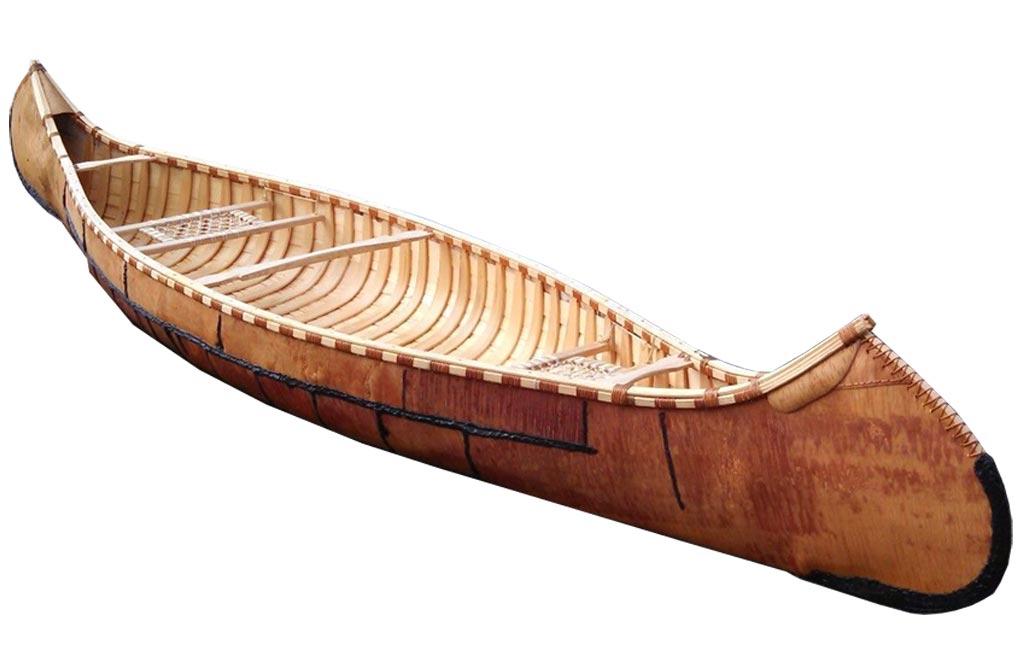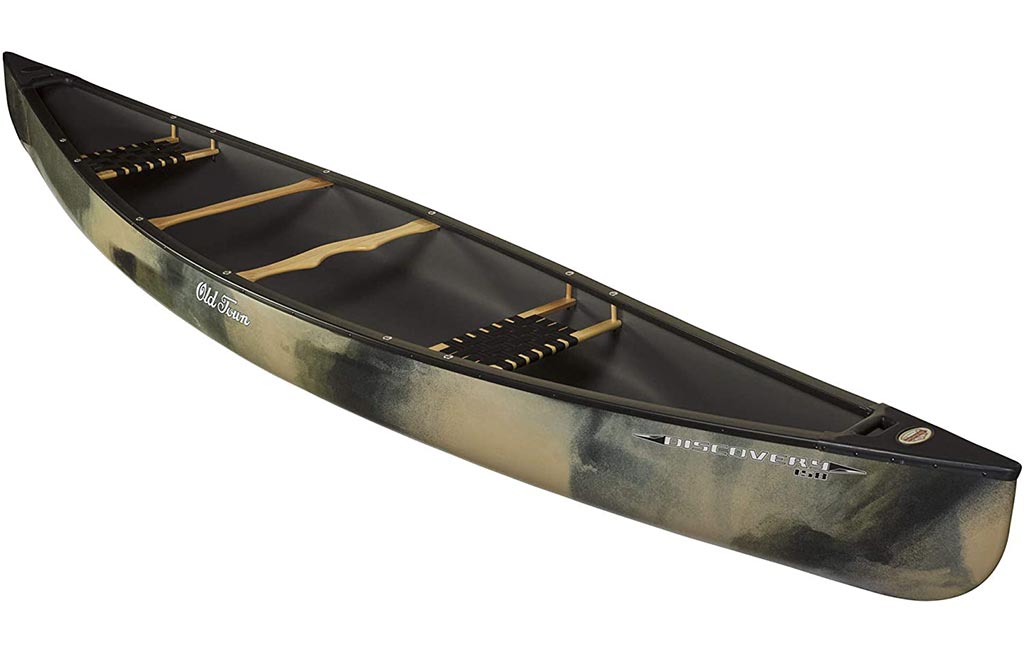
With ample room for friends, gear, and the dog, the beloved canoe is one of the greatest ways to get into the outdoors. Canoes have been navigating waters for centuries, and while materials have changed a lot over the years, their shapes and overall design still nod to those first floating crafts.
What Type Of Adventure Awaits?
Before you break out your wallet, you'll want to figure out what type of water and adventures are on the horizon!
What kind of paddling do you want to do? Flatwater, whitewater, meandering rivers, fishing, a bit of everything? How much gear do you want to bring? Are you going out for weeks on end, or just going out for some overnights?
Let’s mentally paddle through some of the most common canoe shapes, the different types of materials canoes are made from, and the pros and cons of both.
Hull Shape 101
While the main differences (in both price and performance) between canoes manufactured today mostly come from the materials they're made of — and we'll get a lot more into that below — knowing the basics about hull shapes is still useful.
There are three main shapes at play: Flat, Shallow Arch, and Shallow V. Many manufacturers mix these shapes together to make their canoes more well-rounded. When buying one, the overall shape you'll want depends on two factors: How much space you want and the type of water you plan to paddle. Once you determine those two pieces, you'll be close to selecting your perfect canoe.

Flat
The most common shape found in basic, recreational canoes. Canoes with a flat hull shape have great primary stability (they're difficult to tip when upright and on calm water), but when they're put on edge, that stability decreases.

Shallow Arch
The ultimate hull shape for all-around stability, lots of canoes made today feature some variation of a shallow arch. It's stable when paddled flat, and allows for stability on edge when paddling whitewater or when the lake gets choppy.

Shallow V
Canoes of this shape ride lower in the water, and have what amounts to a keel running along their bottom. This provides good primary and on-edge stability, and they track like nobody’s business. They're great for long-distance touring, but get slower in the water when loaded to the brim with gear.
PRO TIP: If you really want to dive into hull design, rocker, depth, and tumblehome, check out this link from Wenonah Canoes for a ton of diagrams and explanations.
The Right Boat For The Right Adventure
Recreational Canoes
 The Wenonah Fisherman is a classic 14' boat whose 39" width keeps it stable for fishing and lounging.
The Wenonah Fisherman is a classic 14' boat whose 39" width keeps it stable for fishing and lounging.Recreational canoes are what most people think of when they see someone out on a lake in a canoe. These boats are stable, hard to flip, and primed for a long day of fishing out on the lake or similar activities. Coming in lengths ranging from 13’-16’ and widths greater than 36”, these overnight-capable canoes are going to be most at home paddling on the lake during day trips or morning fishing.
Why this might be for you: If you are looking for stability, flatwater hang-outs, fishing, or just getting out when the lake is calm, this is the boat for you!
Why you may want to consider other options: These canoes, while stable, lack agility. Though easy to control, they're more ideal for lake lounging rather than paddling long distances. If you want agility and speed, keep reading!
Touring Canoes
 The 18'6" Wenonah Minnesota II is highly efficient, tracks extremely well, and is — especially in the case of the graphite model above — ultra-light.
The 18'6" Wenonah Minnesota II is highly efficient, tracks extremely well, and is — especially in the case of the graphite model above — ultra-light.Designed for longer distances compared to recreational canoes, touring canoes are made from lighter materials and sit lower in the water. They range anywhere from 16’-19’ in length and are narrower than a recreational canoe, which helps them track well and keep up their speed with minimal effort. Their extra length also creates more room front to back for any extra gear you may be bringing.
Why this might be for you: If you're looking for lake-hopping overnights, room for 2 with the dog, or to carry a heavy load for a weekend, this is it! When you purchase a touring canoe made from lighter-weight materials, speed and plumb-straight tracking are your rewards. A touring canoe can also be a great choice for the recreational user who wants more paddling efficiency.
Why you may want to consider other options: The lightweight materials used in some touring canoes can get pretty pricey. If you find yourself on moving rivers with a need for quicker turning, keep in mind that while these canoes go straight amazingly, they are less maneuverable due to their length. Also, if you want to stand up in your boat and enjoy floor-like stability, it's better to go with a tripping canoe or another more recreational shape.
Tripping Canoes
 The Wenonah Prospector 15's steeply rockered hull and great depth make it stable, maneuverable, and confidence-inspiring in moving water.
The Wenonah Prospector 15's steeply rockered hull and great depth make it stable, maneuverable, and confidence-inspiring in moving water.These canoes are the most commonly used and coveted type by canoe trippers and river expeditioners. Flatter-bottomed, with a pronounced rocker in the stern and bow, they are highly maneuverable in rough whitewater or fast-moving rivers. The widths of these canoes are more akin to those of recreational canoes, but they're a lot deeper; their higher gunwales keep them way above the waterline even packed to the brim with gear. These boats are also made out of the most rugged materials available, shrugging off scraping against rocks and bumps to their hulls. They're commonly found in lengths of 15’-17’.
Why this might be for you: If you're looking for durability in your canoe, this is for you. The old Royalex boats of decades past — and the T-Formex boats of today — can be wrapped around rocks in rapids or run over, then popped back into shape with relative ease. So if you're hard on your gear, you won’t find much that's more bombproof than a tripping canoe. If you're planning on going out for a week on the river, navigating whitewater, and want to bring along everything but the kitchen sink, this is the boat for you.
Why you may want to consider other options: If you want to casually solo a canoe onto your car and get out for a long paddle, this isn't the best boat for the job. While they can be at home on the lake, these canoes are specially designed to pivot and turn quickly with power. With their heavier materials, lack of tracking, and more height above water, they can present you with a bit of a struggle-fest when you just want to go straight on a windy day.
Materials, From Classic to Cutting Edge
Companies are constantly blending and creating new niche materials to make their canoes. Each one has different nuances and pros and cons.

Birch Bark
One of the oldest canoe materials is birch bark. Used by the indigenous peoples of what is now known as North America due to its strength and abundance. Canoes are still made this way today, but are very expensive.
Pros:
- Beautiful
- Fairly light
- Paddles with ease
Cons:
- Very expensive
- Need constant maintenance
- Low durability — forget about bumping your way back to shore
Ideal for: Paddlers with an appreciation for canoeing and its history.

Aluminum
Aluminum canoes were once all the rage. Coming out of WWII, this was the most common canoe material thanks to excess materials left over from war manufacturing. These are made with two canoe sides that are riveted in the middle of the craft.
Pros:
- Extremely durable
- Requires essentially zero upkeep
- Lighter than wood canoes
Cons:
- Conductive to temperature — when it's hot out, the metal is hot, when it's cold out, the metal is cold
- The hull can make a lot of noise
Ideal for: Folks looking for a simple, durable, and cost-effective canoe.

Polyethylene
Plastics made their entrance into canoe manufacturing long ago. Canoes made with polyethylene are cheap to make, and very durable. They are becoming less and less common though, due to the inability to manufacture them in newer shapes. Some modern tripping and whitewater canoes are made up of multiple layers of this material, depending on design and brand.
Pros:
- Durable, slides over rocks well
- Inexpensive
Cons:
- High temperature and prolonged sun exposure can cause warping
- Quite heavy
- Hard to repair — you'll need to be able to weld plastic
- Very few hull design options
Ideal for: Whitewater fanatics, canoe trippers, someone looking for inexpensive and durable fun.

Royalex
Paddlers rejoice — or rejoiced, rather — Royalex was all but phased out of use for canoe materials in 2014. In Royalex's heyday, it was tough, fairly lightweight, and moderately expensive. While this material wasn't the fastest, it made up for that with its toughness and repairability. While canoes over the past 20 years have changed a ton from a materials standpoint, this was the originator of lightweight durability.
Pros:
- Durable and easy to repair
- Excellent for hard use in whitewater or heavy tripping
Cons:
- Very difficult to find
- Relatively heavy
- Very few hull shapes left in the wild
Ideal for: Whitewater enthusiasts and serious canoe trippers, anyone who can find it.

T-Formex
Royalex prided itself on durability, fixability, and price. What could ever replace that? Enter T-Formex. Sandwiched ABS plastic with foam on the inside is essentially what makes this magical material great for canoes: It has shape memory, is lightweight, and most importantly, it's abrasion and impact resistant. The foam in this sandwich also increases buoyancy — when a T-Formex canoe flips over, they're nearly unsinkable. This newer material makes for an all-around rugged, decently light canoe.
Pros:
- Floats very well
- Bombproof durability
- Can be repaired with ease, even when bent out of shape
Cons:
- Heavier than lighter composite materials
- More expensive than some other options
Ideal for: Just about everything — it's a true every use material. Great for whitewater, fishing, tripping, flatwater and short paddles.

Composites
More and more canoe manufacturers are using composites of materials to create canoes that are strong, lightweight, and very durable. A prime example is Wenonah's Tuf-Weave material, an interwoven fabric of fiberglass and polyester that holds up well to impacts and abrasion. Tuf-Weave in particular, and these types of composites in general, offer a great compromise between weight, performance, and price.
Pros:
- Relatively light
- Good durability and abrasion resistance
- Relatively inexpensive
Cons:
- Compromises between weight, price and durability means it doesn't come in first place in any category
Ideal for: Paddlers looking to balance weight and performance with price and durability.

Aramid
More commonly known by one of its trademarked names, Kevlar — yes, the same stuff they make bulletproof vests from — Aramid is obviously very durable. When building a canoe out of it, companies will lay up Aramid and reinforce any stress points with aluminum or poly plastic. What you end up getting is a really rigid, lightweight, strong material that is also very fast in the water. Some of the best whitewater canoes are now a Aramid blend. Canoes made from Aramid are more expensive than ones made from fiberglass composites, but less expensive than pure carbon boats.
Pros:
- Very lightweight
- High durability and abrasion resistance for its weight
- Efficient to paddle and fast
Cons:
- Less durable than heavier composites
- One of the more expensive materials
Ideal for: Paddlers who keep their canoe's strength to weight ratio at the front of their mind.

Carbon
The fastest, lightest, and most expensive option, canoes made from carbon lead the pack in speed and paddling efficiency. Like anything made from carbon, however, these canoes can be brittle and become compromised from impacts.
Pros:
- Weighs next to nothing
- Decent durability in most use cases
- Very fast, extremely efficient to paddle
Cons:
- Brittle, not suited for impacts
- The most expensive material
Ideal for: Competitive canoe racers, paddlers who are looking for the lightest canoe they can get.
Materials Round-up
Let’s cut through the canoe materials fog a bit. Most canoe manufacturers can mix and match materials to hull and canoe shapes. What this means is that, if one of these materials sounds best for you, we either most likely have it, or can get it in one of the canoe shapes mentioned above.
Canoe Material Quick Reference Table
| Material | Price | Weight | Durability |
|---|---|---|---|
| Birch Bark | $$$$$ | ★ ★ ★ | ★ ★ |
| Aluminum | $ | ★ ★ ★ | ★ ★ ★ ★ ★ |
| Polyethylene | $$ | ★ | ★ ★ ★ ★ |
| Royalex | $$ | ★ ★ | ★ ★ ★ ★ ★ |
| T-Formex | $$$ | ★ ★ | ★ ★ ★ ★ ★ |
| Composite | $$$ | ★ ★ ★ | ★ ★ ★ ★ |
| Aramid | $$$$ | ★ ★ ★ ★ | ★ ★ ★ |
| Carbon | $$$$$ | ★ ★ ★ ★ ★ | ★ ★ |
So what are some of the considerations you could make in regards to materials? Someone a little older may want a lighter weight canoe to easily lift it on to their car; someone portaging a lot may want to focus on durability while still being weight-conscious.
There are in-betweens with most materials and shapes — while you can use the lightest canoe around for anything, just be cognizant of the fact that it's made of more fragile materials. You can paddle whatever your heart desires, and for whatever adventure you want to go on.
Get A Canoe, You Won’t Regret It

Look, can a whitewater canoe go on a lake trip? Totally. And carbon canoes can go into whitewater. Are those ideal matches? Not really. But there are no real rules to what can work where — the canoe you choose is up to you. So sit in a few and see how they paddle.
Canoeing — in any form — is one of the greatest outdoor recreational opportunities available. It can provide you with new skills and push your limits, or it can provide you with nothing more than knowing how well your sunscreen works and what the limits of relaxation can be. With your new adventure in mind, get out there and paddle!
Ready to get out on the water? Check out our selection of canoes here.
